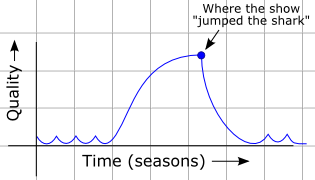In their latest issue, 56:2, they’ve “jumped the shark”* with their Mesomania.
The issue includes a book review of Jerry Grover’s book, “Geology of the Book of Mormon.” I’ve commented on this book in the past. Jerry’s a great guy, and his book is interesting and well reasoned, but it’s nothing but confirmation bias. It’s entirely based on the premise of volcanoes, which we all know are never once mentioned in the text.
Here’s the Mesomania logic:
1. The Book of Mormon took place in Mesoamerica.
2. Mesoamerica has lots of volcanoes that are a significant part of the Mayan lifestyle and culture.
3. Therefore, the destruction in 3 Nephi must have been caused by volcanoes.
The logical fallacies here are easy to identify for those not suffering from Mesomania. The most obvious one is this: the Book of Mormon never mentions volcanoes!
Not only are volcanoes never mentioned in the text, but the supposed impact of volcanoes happened exactly once over 1,000 years in a land supposedly dominated by volcanoes. It’s an absurd proposition, of course. For an explanation of volcanoes in that region, go here. Then there is the matter of earthquakes, which occur I think twice in the Book of Mormon. Go to any earthquake map and you’ll see that in Mesoamerica, earthquakes are a frequent occurrence. The real Book of Mormon lands should have serious earthquakes only rarely–and no volcanoes.
Because Mesomaniacs start their thinking with a premise that contradicts what Joseph and Oliver clearly taught–i.e., that Cumorah is in New York–what do we expect other than logical fallacies?
___________________
Here is the summary of the book review, with my comments in red. You can download the entire book review as a pdf here.
Geology of the Book of Mormon
The summary is bad enough, but the rest of the article is even worse. Here are some bonus passages from the full article:
Using the geology of Mesoamerica, he tests some of the more popular geographic models, such as Sorenson’s, to see if the geography matches the geologic settings that would have been necessary to cause the events described within the Book of Mormon. As I pointed out already, this article and Jerry’s book are purely bias confirmation.
Grover shows, clearly, that the geology of the Great Lakes region does meet the requirements of certain events, such as the mist of darkness (3 Ne. 8:19–22). This is a classic straw man argument. I don’t know of anyone except Aston who promotes a “Great Lakes region” argument for the Book of Mormon the way the Mesomania scholars characterize it, such as FairMormon, here. [BTW, that article uses information that FairMormon knows is false, but they refuse to correct it because the falsehood corroborates their theory but the truth does not.] Not only is this a straw man argument (attacking a fiction created by the Mesomania scholars), but it’s a red herring because it distracts from the reality that Mesomaniacs don’t want people to know about. Google “New Madrid earthquake” and you’ll see that everything described in 3 Nephi has actually occurred along the Mississippi River, including the mist of darkness, within recorded history. Here’s the USGS site on the topic.]
Various geologic scenarios are presented and evaluated in a step-by-step progression, beginning with a volcano-only event and then progressing to the possibility of multiple events, such as a volcanic
eruption and a major earthquake acting concurrently. All of the “various geologic scenarios” involve volcanoes! And yet, as I pointed out, the specific items described in 3 Nephi have occurred in the Mississippi River valley without any volcanic action–just as the text describes them. The “volcano requirement” is pure fiction, concocted to exclude alternatives to the Mesoamerican setting. How do they explain Mormon’s failure to even mention volcanoes? They don’t, but they use the typical methodology of inferring whatever isn’t in the text that they need to support their theory. This is what I call the “Sorenson translation” and the entire two-Cumorahs/Mesomania theory depends on it.
I went into the book with a rather critical eye, which, I think, made me sensitive to some of the imperfections, but by the time I reached chapter 12, “Best Fits for Locations and Events,” I found myself intrigued by Grover’s interpretations. [This is one of my favorite passages. Mesomaniacs always claim they apply a “critical eye,” yet never once does the reviewer question the underlying premise (that the Book of Mormon took place in Mesoamerica) nor the obvious problem that the text never mentions volcanoes. Instead, his “critical eye” notices things such as typos, a lack of uniformity in figures, and a bibliography that is “not as extensive as I would have liked” because Jerry didn’t cite two of the author’s own articles–one of which is titled “Volcanic Destruction in the Book of Mormon.” That’s what passes for criticism when one is “reviewing” a book that confirms one’s biases.]
__________________
If Meso BYU Studies was interested in a serious book review, maybe it would have someone who doesn’t already agree with the major premise–someone whose criticism would include more than complaints that his own articles weren’t cited–do the review.
But it never will.
This book review is consistent with the overall editorial stance of the journal. Like the rest of the citation cartel, BYU Studies will never publish a side-by-side comparison of alternative Book of Mormon geography theories as described by their respective proponents, let alone an honest critique of Mesomania and the associated bias-driven articles that permeate what passes for LDS scholarship in this area.
___________________
*Jumping the shark is described this way: “Jumping the Shark is the moment when an established long-running series changes in a significant manner in an attempt to stay fresh. Ironically, that moment makes the viewers realize that the show’s finally run out of ideas. It’s reached its peak, it’ll never be the same again, and from now on it’s all downhill.”
Source: Book of Mormon Wars

